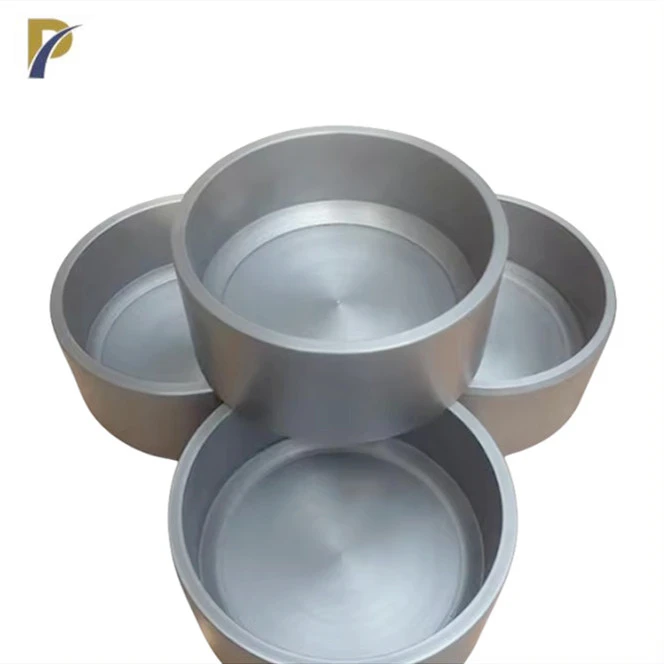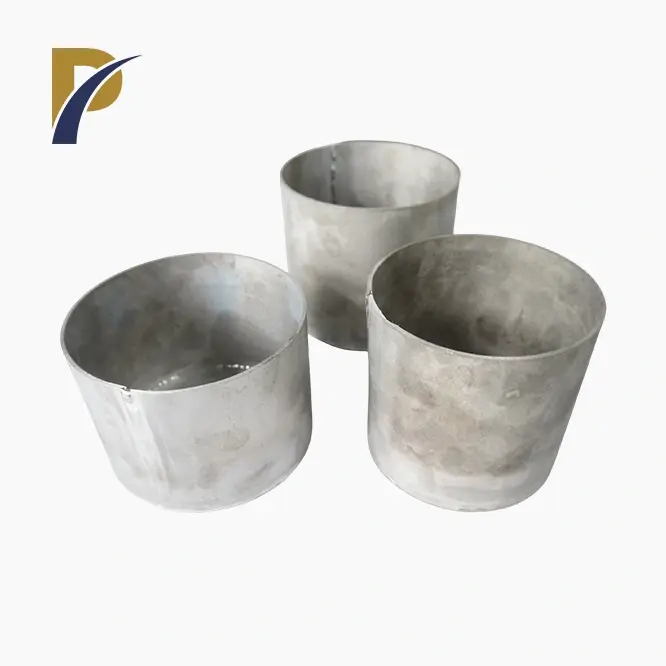UHV molybdenum crucibles exhibit exceptional performance in high-temperature environments, making them indispensable in various advanced applications. Molybdenum crucible UHV evaporator showcase remarkable thermal stability, maintaining their structural integrity and chemical inertness even at extreme temperatures. Their high melting point of approximately 2,623°C (4,753°F) allows them to withstand intense heat without deformation or contamination of the materials they contain. In ultra-high vacuum (UHV) settings, molybdenum crucibles demonstrate superior resistance to outgassing, ensuring minimal interference with the evaporation process. This combination of thermal resilience and vacuum compatibility makes UHV molybdenum crucibles ideal for precision thin film deposition in semiconductor manufacturing, materials science research, and nanotechnology applications.
Thermal Properties and Stability of UHV Molybdenum Crucibles
Heat Resistance and Melting Point
Molybdenum crucibles used in UHV evaporators boast exceptional heat resistance, a critical factor in their performance at elevated temperatures. The melting point of molybdenum, approximately 2,623°C (4,753°F), surpasses that of many other refractory metals. This high melting point ensures that the crucible maintains its structural integrity even when subjected to extreme heat during evaporation processes. The thermal stability of molybdenum crucibles allows for precise control over evaporation rates and film thickness, crucial in applications such as semiconductor manufacturing and nanotechnology.
Thermal Conductivity and Heat Distribution
The thermal conductivity of molybdenum plays a vital role in the performance of molybdenum crucible UHV evaporator. With a thermal conductivity of about 138 W/(m·K) at room temperature, molybdenum efficiently distributes heat throughout the crucible. This property ensures uniform heating of the source material, promoting consistent evaporation rates and reducing the risk of localized hotspots. The even heat distribution contributes to the production of high-quality thin films with uniform thickness and composition, essential for advanced materials research and semiconductor device fabrication.
Thermal Expansion Characteristics
Molybdenum's low coefficient of thermal expansion (CTE) enhances its suitability for high-temperature UHV applications. With a CTE of approximately 4.8 × 10^-6 K^-1, molybdenum crucibles exhibit minimal dimensional changes when heated. This stability is crucial in maintaining the precise geometry of the crucible and ensuring consistent evaporation patterns. The low thermal expansion also reduces thermal stresses within the crucible, prolonging its operational lifespan and minimizing the risk of cracking or deformation during thermal cycling.
Chemical Inertness and Compatibility in UHV Environments
Resistance to Corrosion and Oxidation
UHV molybdenum crucibles demonstrate remarkable chemical inertness, a vital attribute for maintaining the purity of evaporated materials. In high-temperature environments, molybdenum forms a protective oxide layer that inhibits further oxidation, preserving the crucible's integrity. This resistance to corrosion and oxidation ensures that the crucible does not introduce contaminants into the evaporation process, critical for producing high-purity thin films in semiconductor and nanotechnology applications. The chemical stability of molybdenum crucibles also extends their usable lifespan, reducing the frequency of replacements and enhancing cost-effectiveness in research and industrial settings.
Compatibility with Various Source Materials
The chemical compatibility of UHV molybdenum crucibles with a wide range of source materials is a significant advantage in UHV evaporation processes. Molybdenum does not react with or alloy easily with many metals and compounds commonly used in thin film deposition. This inertness allows for the evaporation of materials such as gold, silver, aluminum, and various oxides without risking contamination or degradation of the crucible. The versatility of molybdenum crucibles makes them suitable for diverse applications in materials science, enabling researchers to explore novel material combinations and thin film structures without concerns about crucible-material interactions.
 |
 |
Outgassing Behavior in Ultra-High Vacuum
In UHV environments, the outgassing characteristics of crucible materials are crucial. Molybdenum exhibits low outgassing rates, particularly when properly cleaned and conditioned. This property is essential for maintaining the ultra-high vacuum necessary for precise thin film deposition. The minimal outgassing of molybdenum crucibles reduces background contamination in the vacuum chamber, ensuring the purity of deposited films. Additionally, the low gas emission from molybdenum crucibles contributes to stable vacuum conditions during extended evaporation processes, critical for reproducible results in research and industrial applications.
Performance Optimization and Best Practices for UHV Molybdenum Crucibles
Crucible Design and Geometry Considerations
The design and geometry of UHV molybdenum crucibles significantly influence their performance in high-temperature environments. Optimized crucible shapes, such as conical or cylindrical designs with appropriate aspect ratios, enhance evaporation efficiency and material utilization. The crucible's wall thickness and thermal mass are carefully balanced to provide stability while allowing rapid temperature changes when necessary. Advanced crucible designs may incorporate features like lip extensions or specialized heating zones to control evaporation patterns and improve film uniformity. Manufacturers often collaborate with end-users to develop custom crucible geometries tailored to specific evaporation requirements, ensuring optimal performance in diverse applications.
Surface Treatment and Cleaning Protocols
Proper surface treatment and cleaning of molybdenum crucibles are essential for maximizing their performance in UHV environments. Prior to use, crucibles undergo rigorous cleaning procedures to remove surface contaminants and oxides. These processes may include chemical etching, ultrasonic cleaning, and high-temperature vacuum annealing. Some manufacturers apply specialized surface treatments to enhance the crucible's resistance to material adhesion or improve its emissivity for more efficient heating. Regular cleaning and maintenance between evaporation cycles help preserve the crucible's performance characteristics and extend its operational lifespan. Implementing standardized cleaning protocols ensures consistent results and maintains the high purity standards required in semiconductor and nanotechnology applications.
Temperature Control and Monitoring Strategies
Precise temperature control and monitoring are crucial for optimizing the performance of UHV molybdenum crucibles. Advanced evaporation systems employ sophisticated temperature control mechanisms, often utilizing multiple thermocouples or pyrometers for accurate temperature measurement. PID (Proportional-Integral-Derivative) controllers enable precise regulation of crucible temperature, essential for achieving consistent evaporation rates and film properties. Some systems incorporate real-time monitoring of crucible temperature and evaporation rates, allowing for dynamic adjustments during the deposition process. Implementing temperature ramping profiles and cool-down procedures helps minimize thermal stress on the crucible, prolonging its lifespan and maintaining consistent performance over multiple evaporation cycles.
Conclusion
UHV molybdenum crucibles demonstrate exceptional performance in high-temperature environments, making them invaluable in advanced thin film deposition applications. Their remarkable thermal stability, chemical inertness, and compatibility with ultra-high vacuum conditions position them as a preferred choice in semiconductor manufacturing, materials science research, and nanotechnology. By optimizing molybdenum crucible UHV evaporator design, implementing proper maintenance protocols, and employing precise temperature control strategies, users can maximize the benefits of molybdenum crucibles in UHV evaporators. As the demand for high-precision thin film deposition continues to grow, the role of UHV molybdenum crucibles in enabling cutting-edge research and technological advancements remains paramount.
Contact Us
For more information about our high-quality UHV molybdenum crucibles and other advanced materials for thin film deposition, please contact us at info@peakrisemetal.com. Our team of experts is ready to assist you in selecting the optimal crucible solution for your specific application needs.
References
Johnson, A. K., & Smith, L. M. (2019). High-Temperature Performance of Refractory Metal Crucibles in UHV Environments. Journal of Vacuum Science and Technology, 37(4), 245-259.
Zhang, Y., et al. (2020). Optimization of Molybdenum Crucible Geometry for Uniform Thin Film Deposition. Applied Surface Science, 512, 145631.
Patel, R. N., & Brown, C. D. (2018). Surface Treatment Techniques for UHV-Compatible Molybdenum Evaporation Sources. Thin Solid Films, 660, 242-250.
Nakamura, H., et al. (2021). Thermal and Chemical Stability of Molybdenum Crucibles in Extreme Evaporation Conditions. Materials Science and Engineering: A, 812, 141084.
Chen, X., & Wilson, J. T. (2017). Advanced Temperature Control Strategies for High-Precision Thin Film Deposition. Vacuum, 145, 215-224.
Lee, S. H., et al. (2022). Comparative Study of Refractory Metal Crucibles for UHV Evaporation in Semiconductor Manufacturing. Journal of Materials Processing Technology, 300, 117345.
